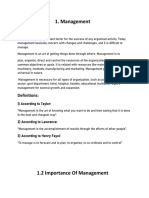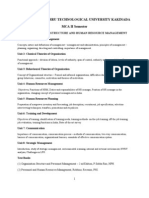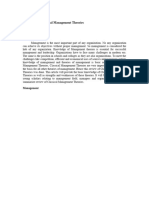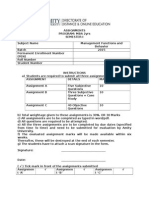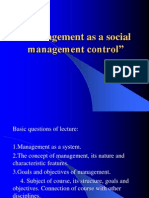CH 01
CH 01
Uploaded by
sivaranjaninatarajanCopyright:
Available Formats
CH 01
CH 01
Uploaded by
sivaranjaninatarajanOriginal Title
Copyright
Available Formats
Share this document
Did you find this document useful?
Is this content inappropriate?
Copyright:
Available Formats
CH 01
CH 01
Uploaded by
sivaranjaninatarajanCopyright:
Available Formats
Chapter 1: Basic Management Principles
Overview
This chapter introduces a lot of information regarding management. The topics cover a lot of different areas. There are a lot of different theories presented; be sure students concentrate on the contributions of each. This provides an excellent background for students.
Lecture Notes A. Principles and Theories of Management
1. Classical Management Theories focused on the efficiency of the workforce with little regard for the human element. Scientific management theorists include: Frederick W. Taylor was known as the father of Scientific Management, the emphasis was efficiency. His belief was that management should plan, select, train, and control, while workers should perform. Lillian and Frank Gilbreth followed Taylors approach. They developed a system for classifying hand motions into 18 elements known as therblig. Henry L. Gantt became concerned with the human side; he developed the Gantt chart in 1917. William H. Leffingwell applied principles to office work in his book Scientific Office Management. Administrative management focused on what good managers do: It was originated by Henri Fayol in his book General and Administrative Management. He set forth a list of 14 principles. Review in the text. Max Weber described ideal organization as a bureaucracy. 2. Human Relations Management Theory arose because the human element was being ignored. Studies began in the early 1920s. The Hawthorne studies were conducted by Mayo, Roethlisberger, and their associates in the early 1920s. They began as a study of effect of specific factors on productivities, but conclusions showed personal attention made the most difference. The most prominent theories include: Maslows hierarchy of needs demonstrates human needs Review figure 1-2. Herzbergs motivation-hygiene theory of motivation Review figure 1-3. 3. Behavioral Science Approach gained popularity in the mid 1920s and continues through today. Organizational Behavior Theories were developed by Douglas McGregor and Rensis Likert. McGregors Theory X and Theory Y as the bases for management theories, classical management is based on X and Y and is a more humanistic view
Likerts leadership model includes a leadership styles between the two extremes of X and Y 4. Management Science Theory came from the need for better models to help with huge logistical moves as WW II started. More emphasis was placed on operations research and management. The quantitative approach related to planning and controlling in the decision making process. Software is available for many of these processes including budgeting, scheduling, and inventory control 5. Contemporary Management Approaches began being applied in management. Systems theory is an extension of the human relations, it began getting attention in the 1950s Contingency theory says no one approach can work in all situations and organizations. Facts of a situation must be evaluated and then a tool or process can be chosen. Total Quality Management was advocated by W. Edwards Deming. He believed in using a constant standard and tracking quality using statistics.
B. The Functions of Management
1. Planning is the most important and basic management function. Its purpose is the define where the organization wants to go, what goals it wants to achieve, who is responsible for what, and how it will be performed. Planning increases the likelihood of success. Organizational goals should be derived from its mission statement, and the objectives should be based on the goals (both long-term and short-term) The strategy can be created once the objectives are set in place. It is a plan or guide for using the resources to meet the objectives. The plans may be different types (strategic, tactical, operational, contingency). Standing-use plans and single-use plans are used to prepare for problems or emergencies. Coordinate and integrate resources needed for success including people, equipment, budgets, and facilities. Many factors should be considered in each area to optimize the situation 2. Organizing is a necessary as a result of planning; the objective is to achieve maximum efficiency toward organizational goals. The process establishes work groups, materials, and activities necessary to achieve the organizations goals. Principles include unity of command (no one should report to more than one superior), chain of command (authority should be delegated in a chain from top to bottom), and span of control (limited time and ability of each manager) Authority and responsibility are really two different things: Authority is the right to command, while authority is the obligation to perform any assigned duties. Organization charts are graphic representations of the chain of command and levels in the organization; they are developed as a result of the process.
3. Leading is the use of communication by a manager to guide, motivate, influence, and direct peoples efforts toward achievement. Early approaches were focused on traits of an effective leader; however studies have not found any specific trait(s) that are universally effective for all leaders. Review the studies in the text. Contingency theories analyze situational differences and the realization that effective leadership involves more than specific traits or behaviors. Fred Fiedler suggested that the match between the leaders style and the needs of the follower play was important for effective leadership. Paul Hersey and Ken Blanchard developed Situational Leadership Theory which focuses on the readiness of the followers. Other leadership approaches include: Transformational leaders make drastic changes Transactional leaders clarify roles and task requirements Self-leadership uses work teams Effective leadership can be associated with certain characteristics like those listed in the text. However, the approaches vary by level. Legitimate power and authority Coercive power Reward power Expert power Referent power Theories of motivation have evolved from studies of what causes people to act in certain ways. Early theorists include Abraham Maslow (Hierarchy of Needs), Douglas McGregor (Theory X and Y), and Frederick Herzberg (Hygiene factors, Motivational factors, dissatisfiers, and satisfiers) Contemporary Theories are broken down into three schools: Content theories focus on what causes people to act in certain ways; process theories focus on choosing actions; and reinforcement theories look at consequences. 4. Controlling focuses on evaluating performance according to the plans that have been established. It includes four steps: Define and specify critical goals to be measured at all levels. This is a critical step because, if they are not stated clearly, confusion and failure will follow. Appropriate standards must be set for goals to be accomplished. A standard is an expected level of performance; it may be specific and measurable. Compare performance with standards and identify areas where the standards have not been met. Make corrections related to differences between the standard and actual performance. 5. Communication links all managerial functionsno other functions can be fulfilled without communication. It is the process of sharing ideas so that they can be understood and used. Channels include downward, upward, lateral, and diagonal.
Policies are general guidelines and limits; procedures specify behaviors for specific situations. Meetings are a popular means of communicating; managers can spend 1/3 of their time in meetings each week. Review the different types of meetings. Meetings are also discussed in the Office Administration text.
C. Decision Making
1. Organizational Decisions affect the ENTIRE organization; organizational decisions may be made differently than an individual decision. Some decisions are routine (programmed) and others represent situations that have not been handled before (nonprogrammed). 2. Basic Theories include: Classical theory dictates how decisions should be made according to ideal standards under perfect conditions. Behavioral (administrative) theory uses bounded rationality and satisficing, based on the work of Herbert A. Simon. Review the steps presented in each type of approach, as they differ from one another. 3. Logical Reasoning Process results in rational decision making. The steps include: Identify and define the problem. Gather information about the problem. Develop alternative solutions. Evaluate alternatives. Choose an alternative. Implement the decision. Monitor the decision. 4. Creative Thinking is very important; that is how new ideas are generated.
D. Managing Change
1. Effective Change Management is important because, while change is inevitable and necessary, peoples responses vary greatly. Monitor changes to see what unforeseen responses might arise. Choose timing carefully and the scope of change should be appropriate. Work with those in the organization that are supporters of change for support. Maintain open communication with those affected by the change. 2. Tactics for Dealing with Resistance to Change can be helpful. Avoid surprises, keep people informed. Stress value of superordinate (overall) goals.
Set the stage for change; allow questions. Ensure top management support. Make changes only when necessary. Education and communication are important before, during, and after the change. Participation, involvement, empowerment!
Additional Resources for Students
Recommended readings (no texts should be more than two years old):
Inc.
Aldag and Stearns. Management. South-Western Publishing Co. Bedeian, Arthur G. Management. The Dryden Press.
Bittel, Lester R. and John W. Newstrom. What Every Supervisor Should Know. McGraw-Hill Book Co. Carrell, Michael R., Daniel F. Jennings, and Christina Heavren. Fundamentals of Organizational Behavior. Carrell, Michael R. Human Resources Management. John Wiley & Sons, Inc.
Certo, Samuel C. Human Relations Today: Concepts and Skills. Richard D. Irwin, Inc. Champoux, Joseph E. Organizational Behavior: Integrating Individuals, Groups, and Processes. Davis, Fruehling, and Oldham. Psychology: Human Relations and Work Adjustment. McGraw-Hill Book Co. DeCenzo, David A. and Stephen P. Robbins. Human Resource Management. John Wiley & Sons. Dessler, Gary. Human Resource Management. Prentice-Hall.
Donnelly, James, James Gibson, and John Ivancevich. Fundamentals of Management. Richard D. Irwin, Inc. DuBrin, Andrew J. Essentials of Management. DuBrin, Andrew. Human Relations: A Job Oriented Approach. Prentice Hall, Gillespie, Karen R. Creative Supervision. Harcourt Brace Company.
Gomez-Mejia, Luis, David Balkin, and Robert Cardy. Management Human Resources. Haimann and Hilgert. Supervision. South-Western Publishing Co. Harris, Michael. Human Resource Management.
Hellriegel, Don and John W. Slocum Jr. Management. Addision-Wesley Publishing Co. Hersey, Blanchard, and Johnson. Management of Organizational Behavior: Utilizing Human Resources. Higgins, James M. The Management Challenge: An Intro to Management. Macmillan Publishing Co., Inc. Hilgert, Raymond L. and Theo Haimann. Supervision. South-Western Publishing Co. Ivancevich, John M. Human Resource Management. Irwin/McGraw Hill.
Milkovich, George T. and John W. Boudreau. Human Resources Management. Mondy, Noe and Premeaux. Human Resource Management. Prentice-Hall.
Northcraft, Gregory B. and Margaret A. Neale. Organizational Behavior. The Dryden Press. Pearce, John A. II and Richard B. Robinson Jr. Management. McGraw-Hill Book Co. Pride, William and O. C. Farrell. Marketing. Houghton Mifflin. Robbins, Stephen P. and Mary Coulter. Management. Prentice-Hall. Robbins, Stephen P. Organizational Behavior. Prentice-Hall. Rue, Leslie W. and Lloyd Byars. Supervision-Key Link to Productivity. Schermerhorn, John R. Jr. Management. John Wiley & Sons, Inc.
Sherman, Arthur W. Jr. and George W. Bohlander. Managing Human Resources. South-Western Publishing Co. Steers, Richard M. Introduction to Organizational Behavior. Harper Collins Publishers, Inc. Wagner, J. A. and J. R. Hollenbeck. Organizational Behavior.
Current issues of periodicals or business publications are also an excellent resource. Some of the following periodicals have an accompanying Web site. Current Periodical BusinessWeek IAAP Complete Office Handbook Modern Office Technology OfficePro Web Address http://www.businessweek.com http://www.iaap-hq.org/products/handbook.htm
http://www.iaap-hq.org/officepro/toc.htm
The Office The Wall Street Journal http://www.wallstreetjournal.com
You might also like
- Organization and Management of Physical Education and HealthDocument5 pagesOrganization and Management of Physical Education and HealthAnne Santos Rojo50% (4)
- Organization and Mngt. 12 Modules QRTR 1Document15 pagesOrganization and Mngt. 12 Modules QRTR 1remely marcosNo ratings yet
- 1 and 2Document15 pages1 and 2tanjimalomturjo1No ratings yet
- Session 2 Management EvolutionDocument10 pagesSession 2 Management EvolutionSamik SinghNo ratings yet
- ENT117 - MU1 - Introduction To Human Resource ManagementDocument26 pagesENT117 - MU1 - Introduction To Human Resource ManagementSamYeol ParkNo ratings yet
- EOM9PP 01 Manager S+jobDocument25 pagesEOM9PP 01 Manager S+jobSky ChëNo ratings yet
- Theories of ManagementDocument9 pagesTheories of Managementbaby100% (1)
- CM1, CU 1, WK 1-Introduction To Leadership and ManagementDocument16 pagesCM1, CU 1, WK 1-Introduction To Leadership and ManagementMichelle Gliselle Guinto MallareNo ratings yet
- Organization and Management Lesson 1Document12 pagesOrganization and Management Lesson 1christinejgualbertoNo ratings yet
- Theories of ManagementDocument8 pagesTheories of ManagementmasindedaddyNo ratings yet
- intr. to manag.Document26 pagesintr. to manag.mohamad nassrallahNo ratings yet
- Principle of Management Chapter 1Document3 pagesPrinciple of Management Chapter 1hrmesb23No ratings yet
- AE 106 MS Chapter 1Document31 pagesAE 106 MS Chapter 1PEACE- Kia Jane AponestoNo ratings yet
- Library ManagementDocument237 pagesLibrary ManagementeducationdoctorNo ratings yet
- Q:no:1: Discuss Importance of Planning in Organizations. Briefly Describe Types of Plans. Answer: PlanningDocument15 pagesQ:no:1: Discuss Importance of Planning in Organizations. Briefly Describe Types of Plans. Answer: PlanningMomina GondalNo ratings yet
- Management and Organisational Behaviour PDFDocument86 pagesManagement and Organisational Behaviour PDFMadhuri Devi100% (1)
- Lesson 4Document114 pagesLesson 4Database SavvyNo ratings yet
- Sonu MCP OBDocument6 pagesSonu MCP OBsujit kumar mallikNo ratings yet
- Management: MeaningDocument45 pagesManagement: MeaningnarayanNo ratings yet
- Lecture Notes 02 Module 1 Introduction To CM Concept of Mangement, Principles of ManagementDocument12 pagesLecture Notes 02 Module 1 Introduction To CM Concept of Mangement, Principles of ManagementSaurabh MNo ratings yet
- Chapter 1 Concept of ManagementDocument13 pagesChapter 1 Concept of Managementsyera3004No ratings yet
- Module 1Document44 pagesModule 1hrramesh_1447No ratings yet
- Management Unit 1 For Nme PaperDocument17 pagesManagement Unit 1 For Nme PaperPriya Sonu0% (1)
- What Is The Managerial Role?Document9 pagesWhat Is The Managerial Role?Nizam UddinNo ratings yet
- Unit 1 Notes 1.1Document19 pagesUnit 1 Notes 1.1Nishika PalNo ratings yet
- Unit-1 POMDocument18 pagesUnit-1 POMdubeshiva22No ratings yet
- Designing Adaptive Organizations: Guess PaperDocument9 pagesDesigning Adaptive Organizations: Guess PaperFahad BhayoNo ratings yet
- Mca OspmDocument14 pagesMca OspmNageswara Rao Thota100% (2)
- Function of ManagementDocument17 pagesFunction of Managementafa758439No ratings yet
- Q1 W1 Mod1 FunctionsTypes&TheoriesofManagementDocument12 pagesQ1 W1 Mod1 FunctionsTypes&TheoriesofManagementCharlene EsparciaNo ratings yet
- Chapter 1 BDocument6 pagesChapter 1 BDolly MehtaNo ratings yet
- Class Notes - Module 1 - Principle of MGMNT - 15th June23Document17 pagesClass Notes - Module 1 - Principle of MGMNT - 15th June23Vaibhav BamboliNo ratings yet
- FRM Part 1Document84 pagesFRM Part 1Puja BarmanNo ratings yet
- Unit I Introduction To ManagementDocument15 pagesUnit I Introduction To ManagementgururajapNo ratings yet
- Effective Class NotesDocument28 pagesEffective Class NotesElton Gil Toriaga MendozaNo ratings yet
- Principles of Management NotesDocument60 pagesPrinciples of Management NotesMatthew NdetoNo ratings yet
- Management and Theories of Management NotesDocument11 pagesManagement and Theories of Management NotesjosephNo ratings yet
- Chapter 1 (3) - 1Document60 pagesChapter 1 (3) - 1Abdisa BogalaNo ratings yet
- Evolution of Management Thought IntroductionDocument6 pagesEvolution of Management Thought IntroductionamoghvkiniNo ratings yet
- MLC AssignmentDocument9 pagesMLC AssignmentRabi AdhikaryNo ratings yet
- IM Unit 1Document15 pagesIM Unit 1pavan kumarNo ratings yet
- PT As AdministratorDocument59 pagesPT As AdministratorRomana VayaniNo ratings yet
- Mob Unit 1Document41 pagesMob Unit 1mba departmentNo ratings yet
- DR - Vara's Introduction To MGTDocument21 pagesDR - Vara's Introduction To MGTDileep Kumar MotukuriNo ratings yet
- Unit 1Document70 pagesUnit 1Nitish GuptaNo ratings yet
- Management Function Behaviour AssignmentDocument21 pagesManagement Function Behaviour AssignmentAnand75% (4)
- Management Concepts - Unit-1Document56 pagesManagement Concepts - Unit-1rakeshparthasarathyNo ratings yet
- QUẢN TRỊ HỌC- TÀI LIỆU HƯỚNG DẪN ÔN TẬP VÀ KIỂM TRADocument18 pagesQUẢN TRỊ HỌC- TÀI LIỆU HƯỚNG DẪN ÔN TẬP VÀ KIỂM TRAmy vuNo ratings yet
- Evolution of Management TheoriesDocument18 pagesEvolution of Management TheoriesKirstine Valerie MandalonesNo ratings yet
- Management NotesDocument8 pagesManagement NotesDarwin BlasabasNo ratings yet
- Lecture 1 - Management As A Social Management ControlDocument20 pagesLecture 1 - Management As A Social Management ControlИрина ЧернышNo ratings yet
- Management: Definition, Nature, Importance and Functions of ManagementDocument17 pagesManagement: Definition, Nature, Importance and Functions of ManagementArunkumar PanneerselvamNo ratings yet
- 1st Monthly Exam Coverage Org and ManagementDocument6 pages1st Monthly Exam Coverage Org and ManagementKee Jay PondocNo ratings yet
- Arnold Van Gennep (1909)Document4 pagesArnold Van Gennep (1909)Dianna Joy SorianoNo ratings yet
- Module 1 NOTES (MED 18ES51) PDFDocument18 pagesModule 1 NOTES (MED 18ES51) PDFHarishNo ratings yet
- Im Notes 3 UnitsDocument45 pagesIm Notes 3 UnitsPranay YalamanchiliNo ratings yet
- Chapter 1 IntroductionDocument10 pagesChapter 1 Introductionasmelash gideyNo ratings yet
- Gale Researcher Guide for: Organizational Theory and Public AdministrationFrom EverandGale Researcher Guide for: Organizational Theory and Public AdministrationNo ratings yet


















